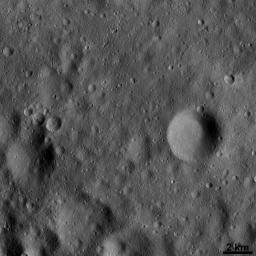
|
Vesta’s Surface at High Resolution: Dominated by Impact Craters
- Click the image above for a larger view
- Full-Res JPEG (1024 x 1024) (192.3 kB)
- Full-Res TIFF (1024 x 1024) (1.1 MB)
Caption:
In this Dawn FC (framing camera) image a large number of craters, formed by collisions into the surface of Vesta, are visible. The craters in this image range in diameter from less than 1 kilometer (0.6 mile) to approximately 4 kilometers (2.5 miles). Whether you are looking at a high-resolution or a low-resolution image, various types of impact craters dominate Vesta's surface. The relatively large circular depressions in this image are older, heavily degraded impact craters. The craters with sharper rims are fresher craters. Clusters of small secondary craters were created by the impact of material and boulders that were ejected when larger primary craters formed.
This image is located in Vesta's Oppia quadrangle and the center of the image is 18.6 degrees south latitude, 346.8 degrees east longitude. NASA's Dawn spacecraft obtained this image with its framing camera on Dec. 13, 2011. This image was taken through the camera's clear filter. The distance to the surface of Vesta is 190 kilometers (118 miles) and the image has a resolution of about 17.5 meters (57 feet) per pixel. This image was acquired during the LAMO (low-altitude mapping orbit) phase of the mission.
Background Info:
The Dawn mission to Vesta and Ceres is managed by NASA's Jet Propulsion Laboratory, a division of the California Institute of Technology in Pasadena, for NASA's Science Mission Directorate, Washington D.C. UCLA is responsible for overall Dawn mission science. The Dawn framing cameras have been developed and built under the leadership of the Max Planck Institute for Solar System Research, Katlenburg-Lindau, Germany, with significant contributions by DLR German Aerospace Center, Institute of Planetary Research, Berlin, and in coordination with the Institute of Computer and Communication Network Engineering, Braunschweig. The Framing Camera project is funded by the Max Planck Society, DLR, and NASA/JPL.
More information about the Dawn mission is online at http://www.nasa.gov/dawn and http://dawn.jpl.nasa.gov .
Cataloging Keywords:
| Name | Value | Additional Values |
|---|---|---|
| Target | 4 Vesta | |
| System | Main Belt | |
| Target Type | Asteroid | |
| Mission | Dawn | |
| Instrument Host | Dawn | |
| Host Type | Orbiter | |
| Instrument | Framing Camera (FC) | |
| Detector | ||
| Extra Keywords | Collision, Crater, Grayscale, Impact | |
| Acquisition Date | ||
| Release Date | 2012-02-13 | |
| Date in Caption | 2011-12-13 | |
| Image Credit | NASA/JPL-Caltech/UCLA/MPS/DLR/IDA | |
| Source | photojournal.jpl.nasa.gov/catalog/PIA15351 | |
| Identifier | PIA15351 | |
